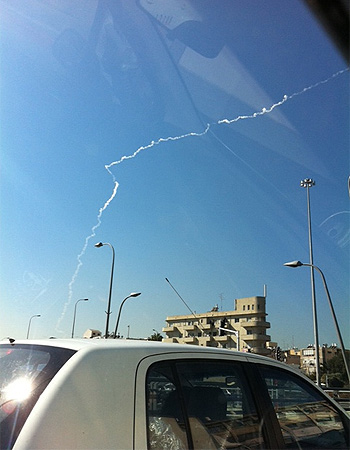Anne's Opinions
The Guardian report is full of ifs and buts, but it looks like a certain amount of concrete planning between the US and Britain is being implemented, with Israel urging haste from the sidelines.
Britain’s armed forces are stepping up their contingency planning for potential military action against Iran amid mounting concern about Tehran’s nuclear enrichment programme, the Guardian has learned.The Ministry of Defence believes the US may decide to fast-forward plans for targeted missile strikes at some key Iranian facilities. British officials say that if Washington presses ahead it will seek, and receive, UK military help for any mission, despite some deep reservations within the coalition government.In anticipation of a potential attack, British military planners are examining where best to deploy Royal Navy ships and submarines equipped with Tomahawk cruise missiles over the coming months as part of what would be an air and sea campaign.They also believe the US would ask permission to launch attacks from Diego Garcia, the British Indian ocean territory, which the Americans have used previously for conflicts in the Middle East.The Guardian has spoken to a number of Whitehall and defence officials over recent weeks who said Iran was once again becoming the focus of diplomatic concern after the revolution in Libya.They made clear that Barack Obama, has no wish to embark on a new and provocative military venture before next November’s presidential election.But they warned the calculations could change because of mounting anxiety over intelligence gathered by western agencies, and the more belligerent posture that Iran appears to have been taking.…Iran appeared to be “newly aggressive, and we are not quite sure why”, citing three recent assassination plots on foreign soil that the intelligence agencies say were coordinated by elements in Tehran.In addition to that, officials now believe Iran has restored all the capability it lost in a sophisticated cyber-attack last year.The Stuxnet computer worm, thought to have been engineered by the Americans and Israelis,sabotaged many of the centrifuges the Iranians were using to enrich uranium.Up to half of Iran’s centrifuges were disabled by Stuxnet or were thought too unreliable to work, but diplomats believe this capability has now been recovered, and the IAEA believes it may even be increasing.Ministers have also been told that the Iranians have been moving some more efficient centrifuges into the heavily-fortified military base dug beneath a mountain near the city of Qom.The concern is that the centrifuges, which can be used to enrich uranium for use in weapons, are now so well protected within the site that missile strikes may not be able to reach them. The senior Whitehall source said the Iranians appeared to be shielding “material and capability” inside the base.…Washington has been warned by Israel against leaving any military action until it is too late.…British officials admit to being perplexed by what they regard as Iran’s new aggressiveness, saying that they have been shown convincing evidence that Iran was behind the murder of a Saudi diplomat in Karachi in May, as well as the audacious plot to assassinate the Saudi ambassador in Washington, which was uncovered last month.“There is a clear dotted line from Tehran to the plot in Washington,” said one.Earlier this year, the IAEA reported that it had evidence Tehran had conducted work on a highly sophisticated nuclear triggering technology that could only be used for setting off a nuclear device.
An additional, possibly connected, piece of information reveals that:
Defense Minister Ehud Barak is currently in London on a state visit, where he met with senior officials, including British National Security Advisor Sir Peter Ricketts.…Meanwhile, an army source told The Jerusalem Post that British military chief Sir David Richards visited Israel this week.Richards was a guest of IDF Chief of General Staff Lt.-Gen. Benny Gantz, the source said.He arrived as “part of an annual visit” aimed at maintaining international cooperation, the source said. The source did not disclose the content of talks held by Richards and Israeli officials.The visit was not announced earlier because it is standard practice in Britain to refrain from publicizing such visits while they occur.
Of course Israel is not sitting quietly on the sidelines, but is quietly making its own preparations:
Israel is also making preparations. Prime Minister Benjamin Netanyahu is working to form a cabinet majority for a strike on Iranian nuclear facilities.Israeli state officials told Britian’s Sky News network that Barak and Foreign Minister Lieberman support a preemptive strike but that the majority of ministers oppose military action fearing a regional flare-up.
Added to all this chatter was the successfulIsraeli test-firing of what was apparently a ballistic missile, although the military are keeping shtum about the details.
Israel carried out a test launch of a rocket propulsion system from the Palmachim Air Force Base Wednesday morning.The smoke trail from the launch was seen by many residents of central Israel in the morning sky.The Defense Ministry said that the experiment had been planned long in advance and that it had ended successfully. No further details were available.A Defense Ministry official declined to comment on the type of rocket tested. But Israel Radio’s military affairs correspondent said a ballistic missile was launched.
And one more item to complete the picture: the IAF completed a major exercise in Italy:
Li.-Col. Y, commander of the 117th Squadron of F-16 fighter jets which took part in the simulation, said his pilots flew over ocean waters west of Italy and carried out maneuvers together with the Italian air force.“We simulated a common enemy. The cooperation between us and the Italians was very good,” the pilot said.The 14 Israeli jets that took part in the drill flew in an area encompassing 800 kilometers (500 miles).The drill was planned six months in advance, and ended last week. Pilots flew in a variety of formations and practiced striking simulated targets.
Hmm. I think I’d better go and check out our shelter, gas masks and emergency supplies…


